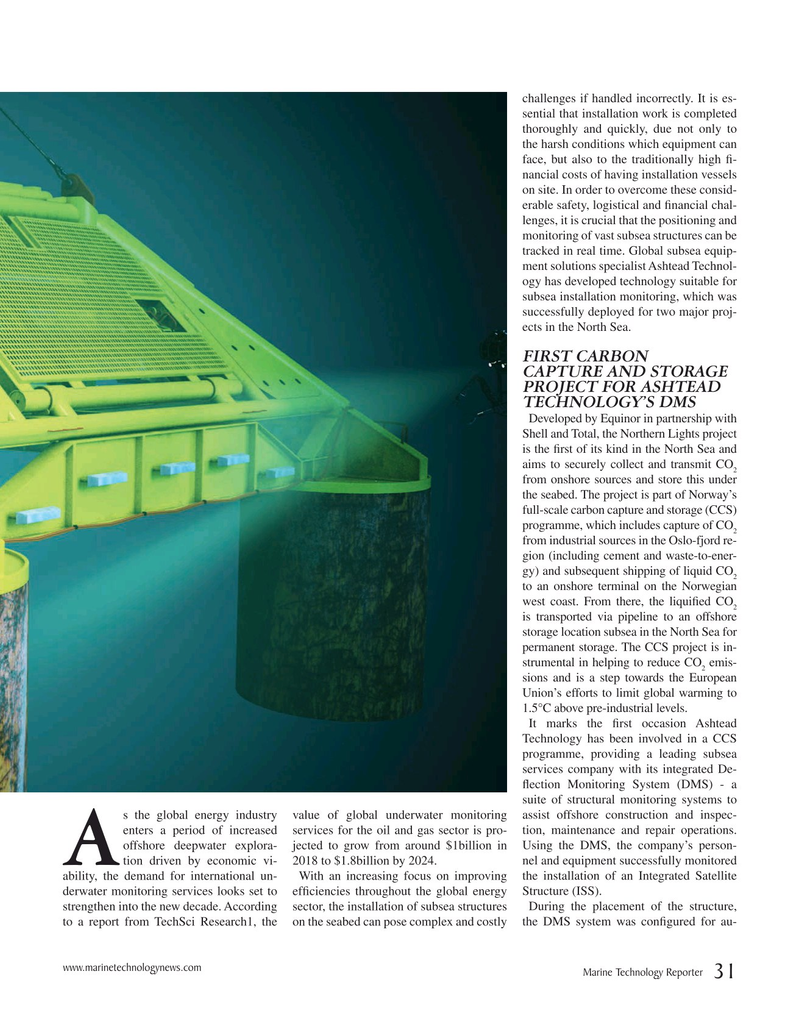
Page 31: of Marine Technology Magazine (April 2020)
Read this page in Pdf, Flash or Html5 edition of April 2020 Marine Technology Magazine
challenges if handled incorrectly. It is es- sential that installation work is completed thoroughly and quickly, due not only to the harsh conditions which equipment can face, but also to the traditionally high f- nancial costs of having installation vessels on site. In order to overcome these consid- erable safety, logistical and fnancial chal- lenges, it is crucial that the positioning and monitoring of vast subsea structures can be tracked in real time. Global subsea equip- ment solutions specialist Ashtead Technol- ogy has developed technology suitable for subsea installation monitoring, which was successfully deployed for two major proj- ects in the North Sea.
FirSt cArbon cApture And StorAge project For AShteAd technology’S dMS
Developed by Equinor in partnership with
Shell and Total, the Northern Lights project is the frst of its kind in the North Sea and aims to securely collect and transmit CO 2 from onshore sources and store this under the seabed. The project is part of Norway’s full-scale carbon capture and storage (CCS) programme, which includes capture of CO 2 from industrial sources in the Oslo-fjord re- gion (including cement and waste-to-ener- gy) and subsequent shipping of liquid CO 2 to an onshore terminal on the Norwegian west coast. From there, the liquifed CO 2 is transported via pipeline to an offshore storage location subsea in the North Sea for permanent storage. The CCS project is in- strumental in helping to reduce CO emis- 2 sions and is a step towards the European
Union’s efforts to limit global warming to 1.5°C above pre-industrial levels.
It marks the frst occasion Ashtead
Technology has been involved in a CCS programme, providing a leading subsea services company with its integrated De- fection Monitoring System (DMS) - a suite of structural monitoring systems to s the global energy industry value of global underwater monitoring assist offshore construction and inspec- enters a period of increased services for the oil and gas sector is pro- tion, maintenance and repair operations. offshore deepwater explora- jected to grow from around $1billion in Using the DMS, the company’s person-
A tion driven by economic vi- 2018 to $1.8billion by 2024. nel and equipment successfully monitored ability, the demand for international un- With an increasing focus on improving the installation of an Integrated Satellite derwater monitoring services looks set to effciencies throughout the global energy Structure (ISS).
strengthen into the new decade. According sector, the installation of subsea structures During the placement of the structure, to a report from TechSci Research1, the on the seabed can pose complex and costly the DMS system was confgured for au- www.marinetechnologynews.com
Marine Technology Reporter 31

 30
30

 32
32
